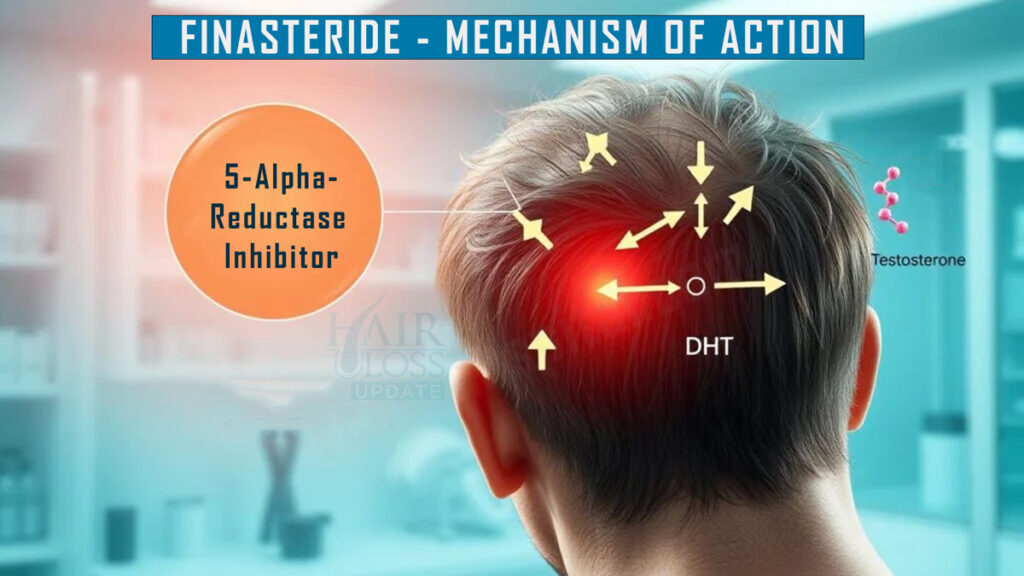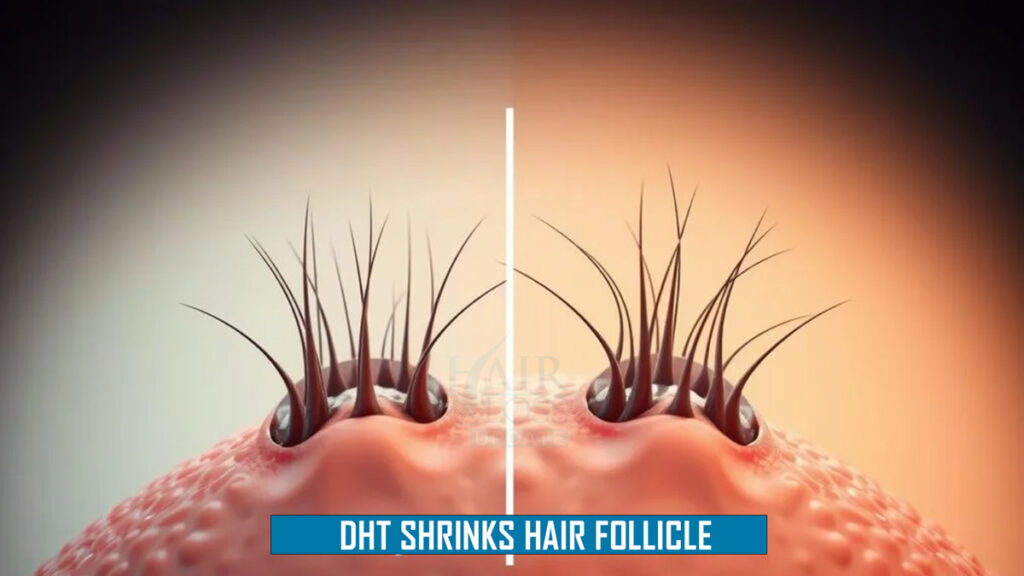Contents
Discover how finasteride for hair loss can help regrow hair and combat male pattern baldness. Learn about its uses, effectiveness, and potential side effects.
Have you ever wondered why some men keep their hair while others lose it early? The answer might be in a pill called finasteride. This pill stops DHT, helping with hair loss and prostate issues. But how does it work?
Finasteride is known as Propecia or Proscar. It’s a big deal in fighting hair loss and prostate growth. It’s used for androgenetic alopecia and benign prostatic hyperplasia (BPH).
Finasteride stops DHT, a hormone that harms hair follicles. By blocking DHT, it helps keep hair and even grow new ones. It’s like a superhero for your scalp!
But finasteride isn’t for everyone. It’s only for men. And like all meds, it has side effects. Some men might have less sex drive or other issues. Also, finasteride might raise the risk of high-grade prostate cancer. So, regular doctor visits are key.
If you’re thinking about finasteride for hair loss, get ready for a detailed look. We’ll cover how it works and what to expect. Let’s explore this hair loss solution together!
Short Summary
- Finasteride is a medication used to treat male pattern baldness and enlarged prostate.
- It works by blocking the production of DHT, a hormone linked to hair loss.
- Finasteride is available under brand names Propecia and Proscar.
- The drug is only approved for use in adult men, not women or children.
- Potential side effects include sexual function issues and increased risk of certain cancers.
- Regular medical check-ups are important when using finasteride.
- Results may take several months to become noticeable.
Understanding Finasteride: An Introduction
I’m excited to explore finasteride, a key treatment for hair loss and prostate issues. This drug is part of a group called 5-alpha reductase inhibitors. It helps manage testosterone levels in our bodies.
What is Finasteride?
Finasteride is a prescription drug that’s gaining attention. It’s mainly used for male pattern baldness and BPH. By stopping the enzyme that turns testosterone into dihydrotestosterone (DHT), it helps hair grow and makes the prostate smaller.
How Finasteride Works
Finasteride works by blocking the enzyme that turns testosterone into DHT. This leads to more hair on the scalp and a smaller prostate. It’s interesting that finasteride can cut DHT levels in the scalp by 70%!

FDA Approval and Brand Names
The FDA has approved finasteride for two main uses. It’s sold as Propecia (1mg) for hair loss and Proscar (5mg) for BPH. Research shows it helps up to 90% of men with hair loss, with 48% seeing better hair after 5 years.
| Brand Name | Dosage | Primary Use |
|---|---|---|
| Propecia | 1mg | Male Pattern Hair Loss |
| Proscar | 5mg | Benign Prostatic Hyperplasia |
Remember, finasteride needs to be taken every day to work. It can take three months to see results, and effects may stop if you stop taking it.
The Science Behind Male Pattern Baldness
Male pattern baldness affects millions of men around the world. It comes from a mix of genes and hormone imbalance. DHT, a hormone, is the main cause of hair loss.
DHT harms hair follicles, making them shrink. This leads to thinner, shorter hair and eventually, no hair. It often starts with a receding hairline and thinning at the crown.

Studies show that by age 50, 30-50% of men will face male pattern baldness. Genetics are a big part, making up about 80% of the risk. Caucasian men are more likely to get it than others.
Good news: treatments like finasteride can lower DHT levels. This slows down hair loss and may even help hair grow back. It works best when started early, when you first see thinning.
“Understanding the science behind male pattern baldness has opened doors to effective treatments. It’s not just about vanity – hair loss can have real psychological impacts.”
While genes matter a lot, lifestyle choices like stress and diet affect hair health too. Taking care of your health might help you keep more of your hair!
Finasteride for Hair Loss: Effectiveness and Usage
Finasteride, also known as Propecia, is a strong tool against hair loss. I’ve used it and seen great results when used right. Let’s look at how to use it best.
Recommended Dosage
The usual dose for male pattern baldness is a 1mg Propecia tablet each day. Taking it every day keeps the drug level steady in your body. I remember to take it at the same time every day to keep up with the routine.
Duration of Treatment
Finasteride is a long-term treatment. It’s not a fast fix, but a long-term care for your hair. At first, you might see results in three months. But the best results come after a year.

Expected Results
Many men see big improvements with Propecia. Studies show it can make hair thicker and more widespread. I’ve seen my hair get thicker and fuller since I started. But, if you stop taking it, you’ll likely lose the hair you gained within a year.
| Time Frame | Expected Results |
|---|---|
| 3 months | Initial signs of hair regrowth |
| 6 months | Noticeable improvement in hair density |
| 12 months | Maximum benefits observed |
Being consistent with Propecia is key. Stick to your daily dose, be patient, and you could see great hair growth. If you’re looking at other options, check out treatments based on your Norwood Scale for a full plan against hair loss.
Treating Benign Prostatic Hyperplasia (BPH) with Finasteride
Finasteride, known as Proscar, is a strong treatment for an enlarged prostate. It comes as a 5mg tablet taken every day. This helps shrink the prostate and makes going to the bathroom easier.
Patients often feel better with less frequent trips to the bathroom, a stronger stream, and starting to urinate easier.
Proscar works by making the prostate smaller. Over time, it can shrink by 20-30%. This shrinkage helps with urinary issues, making life easier for those with BPH.

Doctors might give Proscar alone or with other drugs like alpha-blockers for better results. It’s not a cure but a long-term way to manage BPH. Be patient, as it can take up to 6 months to see the best results.
| Aspect | Details |
|---|---|
| Dosage | 5mg tablet once daily |
| Prostate Size Reduction | 20-30% over 6-24 months |
| Symptom Improvement | Reduces frequent urination, weak stream, difficulty starting urination |
| Treatment Duration | Long-term management (not a cure) |
Stopping Proscar will make the prostate grow back within months. Always talk to your doctor before changing your BPH treatment.
Potential Side Effects of Finasteride
I looked into the side effects of finasteride. It’s key to know them before you start taking it. Some people have bad reactions, but many don’t.
Common Side Effects
Finasteride can affect sex in some users. This includes less desire, trouble getting an erection, and issues with ejaculation. These problems happen to 2.1% to 3.8% of men. But, most men see these issues go away over time. By the fifth year, only 0.3% of men still have these problems.

Serious Side Effects
Very rare side effects are serious and happen to less than 1 in 1,000 people. These can be breast tenderness or growth, testicular pain, or a severe allergic reaction. Some may also feel depressed.
Long-term Effects
Studies are still looking into the long-term effects of finasteride. Some research points to possible ongoing sexual issues in some men, even after stopping the drug. There are also reports of sperm quality changes, which could be a worry for those wanting to have kids.
| Side Effect | Frequency |
|---|---|
| Erectile Dysfunction | 4.9-15.8% |
| Decreased Libido | 3.1-5.4% |
| Ejaculation Problems | 2.1-7.7% |
Talking to your doctor about these side effects before starting finasteride is key. They can help you see the pros and cons. They’ll also keep an eye on your health while you’re taking it.
Precautions and Contraindications
When thinking about using finasteride for hair loss or prostate issues, I need to be careful. This medicine isn’t for everyone. It’s important to know who can’t use it safely.
Women, especially those who might get pregnant, should not take finasteride. It can harm male babies in the womb. Men taking finasteride must not give blood to pregnant women.
If I have liver disease, I must be careful with finasteride. It could change how my body processes the drug, making side effects worse. I should tell my doctor about any liver problems before starting treatment.
Finasteride can change PSA levels, which are key for prostate cancer tests. If I’m on this drug, I must tell my doctor before any prostate tests. This way, the results will be accurate.
| Precaution | Reason |
|---|---|
| Women (pregnant/may become pregnant) | Risk of birth defects in male fetuses |
| Blood donation | Potential exposure to pregnant women |
| Liver disease | Altered metabolism, increased side effects |
| PSA levels | Affects prostate cancer screening accuracy |
Telling all healthcare providers about finasteride use is crucial before any tests or procedures. This helps ensure the results are right and avoids any problems.
Finasteride vs. Other Hair Loss Treatments
Fighting hair loss isn’t the same for everyone. It’s good to compare different treatments to choose the best one. Let’s see how finasteride compares with other popular treatments.
Minoxidil Comparison
Minoxidil is a treatment you put on your scalp. It helps blood flow to your hair follicles, helping them grow. Finasteride works from the inside out. Studies often show finasteride beats minoxidil for male pattern baldness.
Hair Transplant Options
For a lasting solution, consider hair transplants. They move hair from fuller areas to where it’s thinning. These are more expensive and invasive than taking pills.
Natural Alternatives
Some like natural remedies. Saw palmetto and biotin are popular. They’re safe, but not as proven as finasteride or minoxidil. Be realistic about what they can do.
Scalp micropigmentation is another option. It makes your scalp look fuller with tiny tattoos. It’s good for those wanting a simple solution.
| Treatment | Effectiveness | Application | Side Effects |
|---|---|---|---|
| Finasteride | High | Oral pill | Potential hormonal effects |
| Minoxidil | Moderate | Topical solution | Mild scalp irritation |
| Hair Transplant | High | Surgical procedure | Risk of scarring |
| Saw Palmetto | Low to Moderate | Oral supplement | Generally mild |
The best treatment depends on what you need and like. Talking to a healthcare expert can help you pick the right one for your hair loss.
Lifestyle Considerations While Taking Finasteride
Taking finasteride for hair loss is just one part of the equation. A holistic approach to hair health can make a big difference. Let’s dive into some lifestyle factors that can complement your finasteride treatment.
A balanced diet rich in proteins and vitamins is crucial for healthy hair growth. I make sure to include foods like eggs, nuts, and leafy greens in my meals. Regular exercise not only improves overall health but also boosts blood circulation to the scalp, promoting hair growth.
Stress management is key. High stress levels can contribute to hair loss, so I practice relaxation techniques like meditation or yoga. As for my hair care routine, I’ve learned to be gentle. I avoid harsh treatments and opt for mild shampoos to prevent additional damage.
“Patience is a virtue when it comes to hair regrowth. It took me several months to see significant results with finasteride.”
Here’s a quick overview of lifestyle factors to consider:
| Factor | Recommendation |
|---|---|
| Diet | Protein-rich foods, vitamins A, C, D, E |
| Exercise | 30 minutes daily, focus on cardiovascular activities |
| Stress Management | Meditation, deep breathing, regular sleep schedule |
| Hair Care Routine | Gentle washing, avoid heat styling, regular trims |
Remember, finasteride is a long-term solution. I make sure to have regular check-ups with my healthcare provider to monitor progress and address any concerns. By combining finasteride with these lifestyle changes, I’ve seen remarkable improvements in my hair health.
Conclusion
I’ve talked a lot about finasteride as a hair loss treatment. It’s a big help for men with balding. About 80% of men will face this issue at some point.
Finasteride can slow down hair loss and even help new hair grow. Studies show it works well for most men who use it. But, it’s not fast. You need to use it for months to a year to see results.
Choosing finasteride needs careful thought. It’s not good for everyone. Some men have side effects, and it’s not safe for women. That’s why talking to a doctor is key. They can look at your situation and help you decide.
Finasteride is a long-term choice. It’s not just a quick fix. But for many, it’s worth the effort. If you’re thinking about it, take your time, research, and talk to a pro. Your hair health is important, and the right choice is out there for you.
FAQ
What is finasteride?
Finasteride is a medicine for treating male pattern baldness and enlarged prostate. It’s known as Propecia and Proscar.
How does finasteride work?
It stops making dihydrotestosterone (DHT), a hormone that causes hair loss and bigger prostate. Finasteride is a 5-alpha reductase inhibitor that blocks testosterone turning into DHT.
Is finasteride FDA-approved?
Yes, it’s approved by the FDA for treating male pattern hair loss and enlarged prostate.
What causes male pattern baldness?
It’s from genes and hormones, especially DHT. This hormone makes hair follicles shrink, leading to thinner and shorter hair, and eventually hair loss.
What is the recommended dosage for hair loss?
For hair loss, take 1mg of finasteride (Propecia) every day.
How long does it take to see results with finasteride?
You might see results in 3 months. The best results come after 12 months of using it every day.
What is the recommended dosage for BPH?
For BPH, take a 5mg finasteride (Proscar) tablet daily.
What are the common side effects of finasteride?
Side effects include less sex drive, trouble getting an erection, and changes in ejaculation. These happen in less than 2% of men.
Are there any serious side effects of finasteride?
Rare serious side effects include bigger breasts or pain in the testicles, and feeling sad. There’s also a small chance of high-grade prostate cancer.
Can finasteride be used by women or children?
No, women, especially those who might be pregnant, should not use finasteride. It can harm male babies. Children shouldn’t use it either.
How does finasteride compare to minoxidil for hair loss treatment?
Finasteride treats hair loss from the inside. Minoxidil is a cream that helps hair follicles. Using them together can work better.
What are some natural alternatives to finasteride?
Some people try saw palmetto and biotin for hair loss. But, their effectiveness is not proven well.
What lifestyle factors should be considered while taking finasteride?
Eating well, exercising, and managing stress helps your hair health with finasteride. Taking care of your hair gently is also key.
